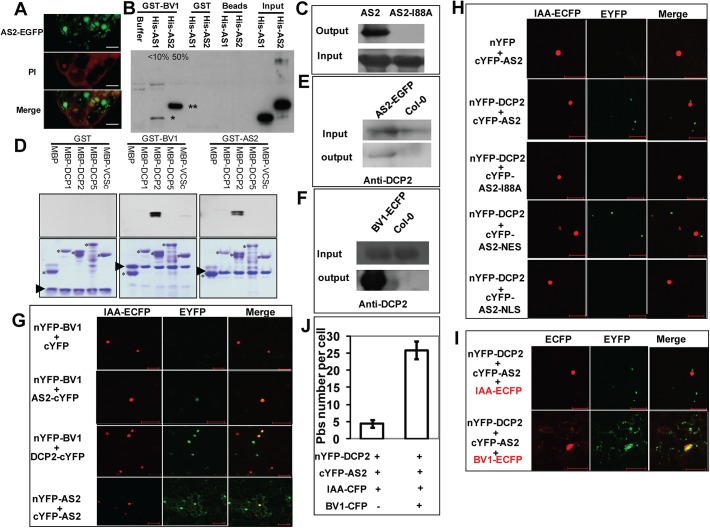Fig 4. BV1 interacts with AS2 and DCP2.
(A) Sub-cellular localization of AS2-EGFP fusion protein expressed from a native AS2 promoter in transgenic Arabidopsis root. Propidiumiodide (PI) was used to stain the nucleus and plant cell wall. Note cytoplasmic AS2 bodies. Bar: 10μm. (B) In vitro interaction of BV1 with AS1 and AS2. Around 50% of the input AS2 protein can be pulled down by GST-BV1, whereas less than 10% of the AS1 protein can be pulled down by GST-BV1. (C) In vitro assay of self-association of WT AS2 and its I88A mutant. Equal input amounts of His-AS2 and His-AS2-I88A were used for GST-AS2 pull down assays. (D) In vitro interaction of BV1 or AS2 with various protein subunits of the P-body. Arrowheads and asterisks indicate the bait proteins and the prey proteins, respectively, in each experiment. (E) In vivo interaction between AS2 and DCP2. Nuclear extracts from AS2p:AS2-EGFP plants were immunoprecipitated by GFP-agrose beads (GFPtrack). The immunoprecipitate was detected by anti-DCP2 antibody. (F) In vivo interaction between BV1 and DCP2. Nuclear extracts from 35S:BV1-ECFP plants was immunoprecipitated by GFP-agrose beads (GFPtrack). The immunoprecipitate was detected by anti-DCP2 antibody. (G) BiFC assay. cDNAs encoding proteins fused to the N- or the C-terminal portion of YFP were constructed. Aux/IAA-ECFP (IAA-ECFP) was used as a nuclear marker. The co-expressed proteins are indicated. Bar = 50μm. (H) BiFC assay of in vivo interaction of DCP2 with AS2, AS2-I88A, AS2-NES and AS2-NLS. Aux/IAA-ECFP (IAA-ECFP) was used as a nuclear marker. The co-expressed proteins are indicated above the photographs. Bar = 50μm. (I) BV1 expression triggers nuclear exit of AS2-DCP2 to the cytosol. Aux/IAA-ECFP (IAA-ECFP) was used as a nuclear marker and also a negative control for BV1-ECFP. The co-expressed proteins are indicated above the photographs. Bar = 50μm. (J) BV1 expression increases the number of P body marked by DCP2-AS2 complex. Twenty cells were examined in this experiment.

